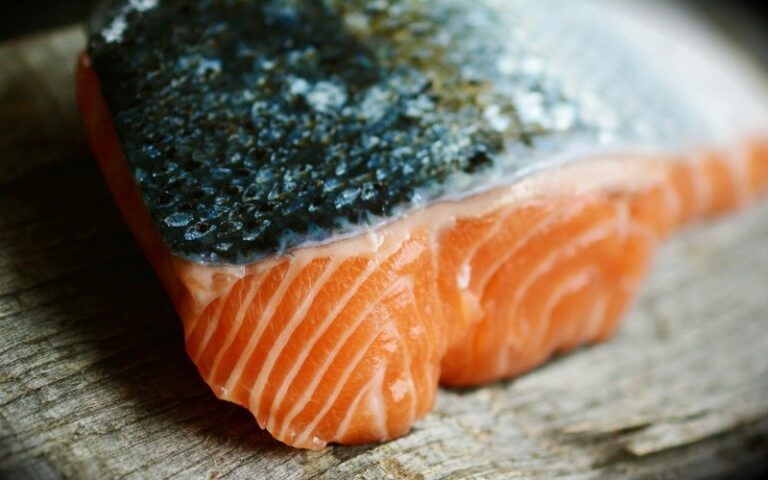By Carolyn Graf
Atlantic salmon (Salmo salar) are found in the temperate and arctic regions of the northern hemisphere. They occur in the rivers of the countries that border both sides of the North Atlantic Ocean, and the Baltic Sea. As an anadromous species, Atlantic salmon live in freshwater as juveniles but migrate to sea as adults before returning up-river to spawn. Atlantic salmon return to their native river, and even the same stretch of the river from which they were born, with amazing accuracy. This means that many ‘populations’ of Atlantic salmon may exist within the same river.
Medieval regulation of salmon fishing in Scotland has its roots in statutes made by King David who is thought to have introduced the feudal system into Scotland. The earliest Act of the Scottish parliament pertaining to fishing, unrepealed by subsequent legislation, was passed in 1424.
This first legislation, having to do with rivers and riverbanks, ensured that rivers were open to all. This was important in a country with few roads. Coastal navigation was vital. Originally this also applied to fishing in these waters. At some point in the 12th century a distinction was made between “whitefish” (all fish from a river) and fish of the salmon kind. This began the long history of laws saying who could fish for salmon where, how, and when.
This right was often separate from the person who owned the land adjacent to the river. In addition, the person who owned the fishing rights also had the right to cross the property near the river. These fishing rights were hereditary and, in the beginning, only pertained to net fishing. By the middle of the 19th century, rod fishing had become economically valuable and rules pertaining to that were added.
One would think that the owners of certain fishing rights would ensure that their fishing would be done in a way to ensure the continuation of the species. This was not always the case. Laws limiting the times of fishing did not limit the number of fish. In this way conservation was less effective.
Two other measures were included to further the conservation of salmon. The first was to limit how fish are caught. The original legislation was designed to prohibit any commercial method which would be too efficient. This eliminated any fixed device set up in the river. The only legal form of netting was “net & coble,” where a seine net of modest efficiency was “shot” in a semi-circle from the riverbank and the two ends were brought together to trap the fish.
The second additional measure was to invoke closed times when fishing was prohibited: roughly from October through January, the main spawning time. During the fishing season there is an additional closure called the “Saturday slap,” originally the 24 hours from midnight Saturday to midnight Sunday, but subsequently lengthened in duration. This was to allow an escapement during the fishing season so that some breeding stock reached the spawning beds.
These laws were rarely enforced, and the first two penalties were light. The third penalty was death, also rarely enforced. Conservation was not a strong consideration during the Victorian era. The supply of fish seemed unlimited. But, by the middle of the 1800’s some fisheries became aware that the number of salmon was declining.
Years of conflict among fisheries ensued. Laws were passed and more or less ignored. Rod fisherman were in conflict with the net fishermen. Different methods of fishing were invented and subsequently banned but the number of commercial fisheries increased and the numbers of salmon continued to decreased.
Although many methods of restocking the river were attempted it wasn’t until the early 1970’s that the Scots discovered how to rear Atlantic salmon to maturity in farms. This resulted in the thriving salmon industry of today. While there is controversy over fish farms impact on the environment, and whether farm salmon are as flavorful as wild salmon, the industry has made salmon available to everyone.
Salmon Fritters
Ingredients:
- ½ pound (about 2 cups) of cold, boiled, boned, salmon
- 2 heaped tablespoons flour
- 2 eggs beaten
- ¼ pint (1/2 cup) milk or cream
- Salt and cayenne pepper
- Oil for frying
For the sauce:
- 4 0z. (1/2 half cup) melted butter
- 2 tablespoons cream
- 2 teaspoons flour
- 2 teaspoon soy sauce
- 2 teaspoons mushroom ketchup (perhaps HP sauce or Worcestershire Sauce could be substituted)
Instructions
Flake the salmon, add the flour, the beaten eggs, and enough milk or cream to make the mixture a soft dough. Season to taste. Have the oil very hot, and drop in tablespoons of the mixture. Fry until golden brown on both sides, then drain on paper. Keep warm.
To make the sauce, mix the cream with the flour and add to the melted butter. Heat it, stirring all the time. When it has thickened slightly add the soy sauce and the mushroom ketchup. Mix well. Serve over the fritters.
These fritters can be made with almost any whitefish or shellfish such as lobster or crab.
Serves 3 to 4.
Sources:
- Iain A. Robertson – Salmon Conservation in Scotland – A History of Legislative Tradition and Private Action
- A Taste of Scotland, Theordora Fitzgibbon, Houghton Mifflin Company, Boston 1971. P.109


